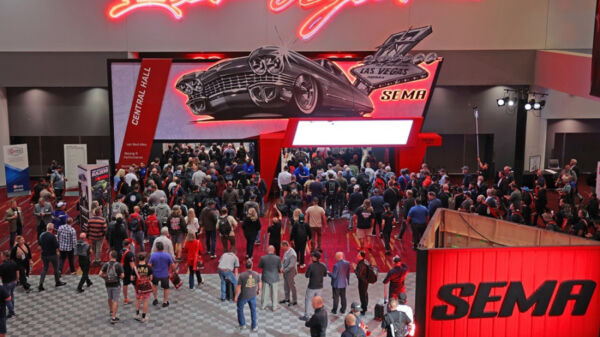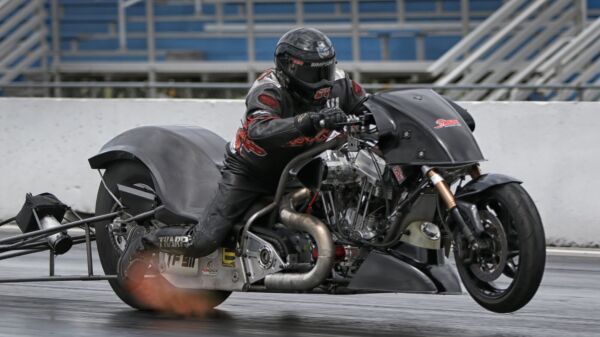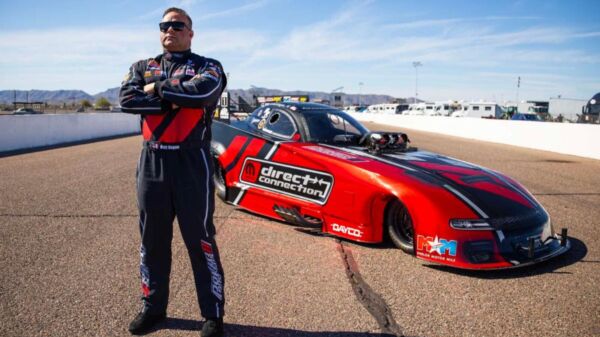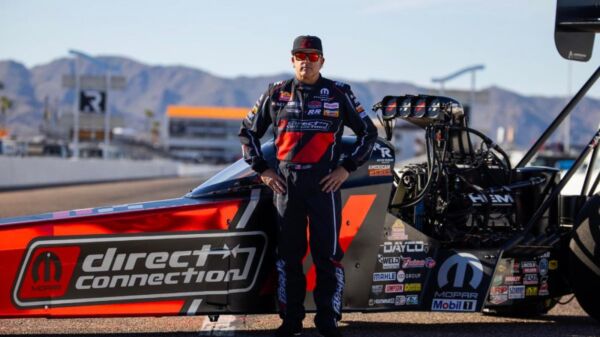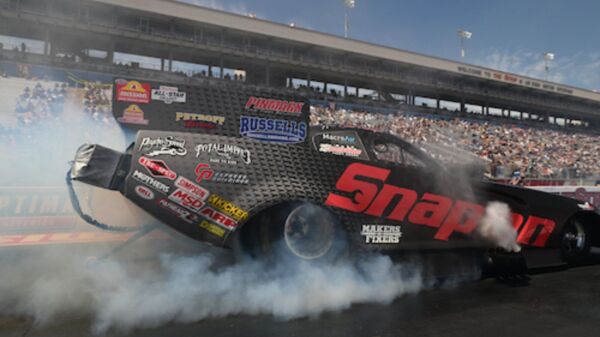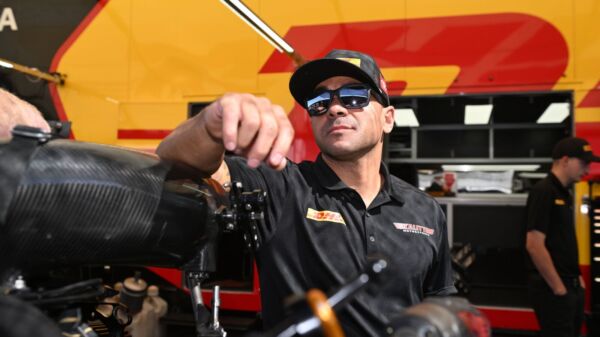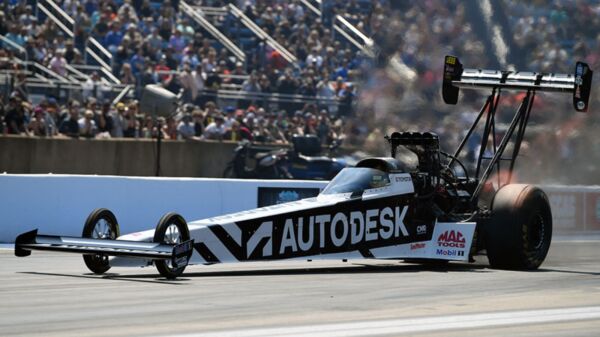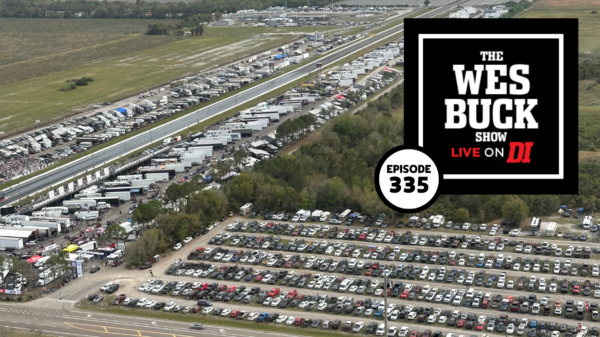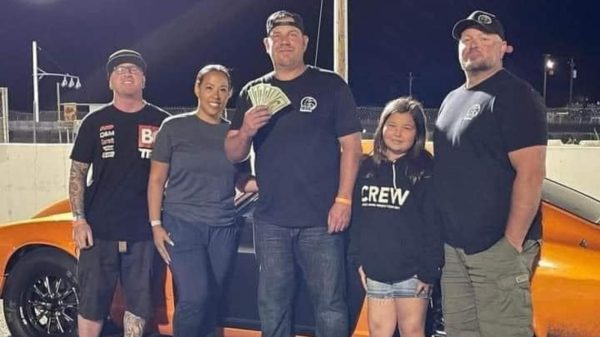It’s 6:30 in the morning and Jason Scruggs is heading to work. He makes a right turn out of the nice, upscale subdivision where he lives with his wife, Alice, and three daughters, all under 10 years old (a fourth is off to her freshman year at college and the oldest is living on her own). It’s a 10-minute drive to home base for the more than 27,000 acres that he and his father, Mitchell, farm in northeast Mississippi, near Tupelo. A left turn would’ve taken him about the same amount of time to reach the nondescript metal garage and race shop where his record-setting Pro Extreme ’63 Corvette resides between races and through the off season.
[Editor’s Note: This story originally appeared in DI #85 in March of 2014.]
Today should be a short work day for Scruggs, only 11 hours or so; when it’s planting or harvesting season, 15 hours plus is the norm. But even now there will be at least 20 employees waiting on him for their daily assignments at “the farm,” as Scruggs always calls it, though this is no Ponderosa-like spread. Instead, it’s an ever-growing collection of plots and tracts that stretch over five counties and range up to 2,000 acres at one location. There are many more in the 30- to 100-acre range, though, wedged in-between local industrial and manufacturing businesses and peacefully coexisting among countless residential retreats.
That also means there are five county offices to visit for certifying each and every piece of land, five county farm agents to meet with in the field and five counties worth of paved roads and gravel paths to travel just to reach his crops and workers. It’s easy to see that Scruggs’ plain-Jane, white Chevy pick-up gets a regular workout as his daily driver.
 “I never really know what I’m going to be doing from day to day and that’s one thing I enjoy about farming; it’s something different every time you turn around. It keeps you busy,” Scruggs says. “Some people think that farmers just plant for a few months and we harvest a few months and then we’re off a few months in between. But it doesn’t work like that. Farming is, for an operation our size, it’s never ending. One crop leads to another crop, and then we’re hauling our grain off, cleaning all the grain storage tanks out this time of year, washing equipment, working on equipment and getting the fertilizer equipment ready for another season and getting the planting equipment ready. It’s just never ending.”
“I never really know what I’m going to be doing from day to day and that’s one thing I enjoy about farming; it’s something different every time you turn around. It keeps you busy,” Scruggs says. “Some people think that farmers just plant for a few months and we harvest a few months and then we’re off a few months in between. But it doesn’t work like that. Farming is, for an operation our size, it’s never ending. One crop leads to another crop, and then we’re hauling our grain off, cleaning all the grain storage tanks out this time of year, washing equipment, working on equipment and getting the fertilizer equipment ready for another season and getting the planting equipment ready. It’s just never ending.”
These days it’s primarily soybeans that pay the bills, with a little corn on the side. The Scruggs used to be known as big cotton farmers, but the cotton crop is down to less than a tenth of their acreage now. “That’s what the market is telling us to do,” Scruggs explains.
Work on the farm is anchored by a fleet of more than a dozen large John Deere tractors that make the daily rounds between sites and typically burn through an astonishing 2,000 to 3,000 gallons of diesel fuel a day, depending on the job and season at hand. To feed that insatiable hunger, Scruggs’ truck often can be seen hauling a trailer outfitted with a thousand-gallon fuel tank from work site to work site.
“When you think about it, you start running 15, 16 pieces of machinery, it takes a good bit just to keep them scattered out. We’ve just got to work it out where you don’t let none of them run out, but it’s not easy; 10 hours goes by pretty quick when you’re trying to do everything,” Scruggs says.
Most of the tractors are equipped, too, with high-tech, GPS-based guidance systems that hold planting and fertilizing lines perfectly straight, with the operator primarily there to make programming selections and ensure the machine is doing its intended job correctly.
“It’s about like an airplane on autopilot. You have to kind of turn it on the ends and do little things here and there, but for the most part it drives itself,” says Scruggs, who explains technology has considerably changed the way he farms, especially over the last decade.
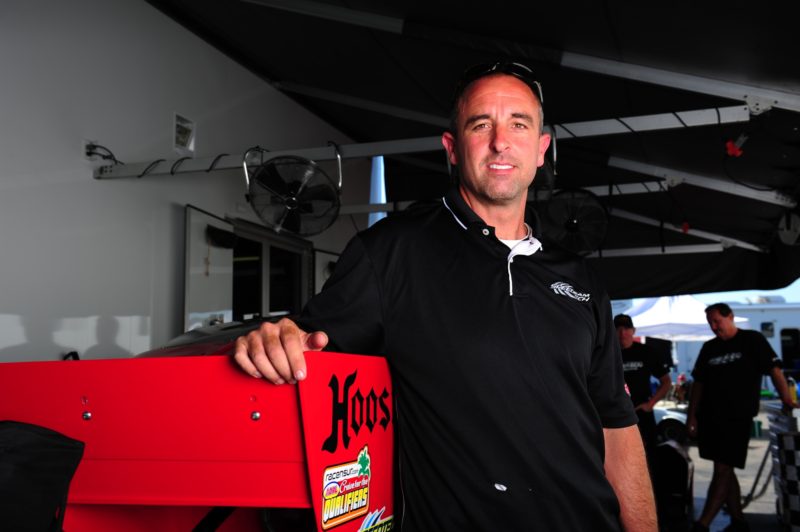 “It’s given us more efficiency when we’re spraying the fields,” he says. “The tractor’s spray rig also works off the GPS, so it’ll cut the spray off to where you don’t overlap. If you get to a corner or something, it’ll cut pieces of your spray boom off automatically if you’ve already sprayed there. So it’s pretty technically advanced; you don’t waste as much chemicals; you don’t waste as much seed. Everything is a lot more precise.”
“It’s given us more efficiency when we’re spraying the fields,” he says. “The tractor’s spray rig also works off the GPS, so it’ll cut the spray off to where you don’t overlap. If you get to a corner or something, it’ll cut pieces of your spray boom off automatically if you’ve already sprayed there. So it’s pretty technically advanced; you don’t waste as much chemicals; you don’t waste as much seed. Everything is a lot more precise.”
Logistically, it’s a monumental task to keep a widespread farm nearly equal to the combined acreage of Disneyworld in Florida running efficiently. Not only is Scruggs responsible for coordinating work schedules, fuel deliveries, seed purchasing, crop allotments, fertilizing cycles and routine maintenance, there’s also the related paperwork and records keeping that goes hand-in-hand with any business.
“It is a lot of paperwork,” he agrees. “We have one secretary that helps just with that, but we do a lot of it ourselves, too. There’s quite a bit of notes that you have to keep up with.
“Not to mention all the stuff that goes wrong and just keeping everything straight and on track. So yeah, farming can get pretty hectic. Each fall, when we’re harvesting, we’re trying to pick cotton and we’re trying to cut soybeans at the same time, so we have a crew of about 15 over here and then another crew about 15 over there. And then we also have a cotton gin and we gin our customers’ cotton, plus our own. So it’s a pretty complex operation that keeps us pretty busy, that’s for sure.”
Still, Scruggs insists he enjoys the challenge and loves the lifestyle.
“It makes for some long days but it’s what I’ve grown up doing my whole life pretty much. When I was a kid still in high school, or even before high school, I was getting out in the summers and I was driving tractors full time, all day long—just like I still do now sometimes. So yeah, I’ve always enjoyed getting out working on stuff and being outdoors and it’s always something different. One minute you might be welding on something, fixing something. The next minute you’re just pulling fuel and putting out fires or whatever. You never know what you’re going to be doing.
“When we’re busy in the fields and stuff, we’ve got everybody stretched pretty thin just trying to run all the equipment and make everything go so a lot of times I’m actually physically working on stuff and getting greasy and dirty and welding and physically out there laboring. And then this time of year, it’s a whole lot of meetings and planning and everything that goes into that also. There’s a lot of different things I do, but I really do like the variety because it keeps things interesting.”
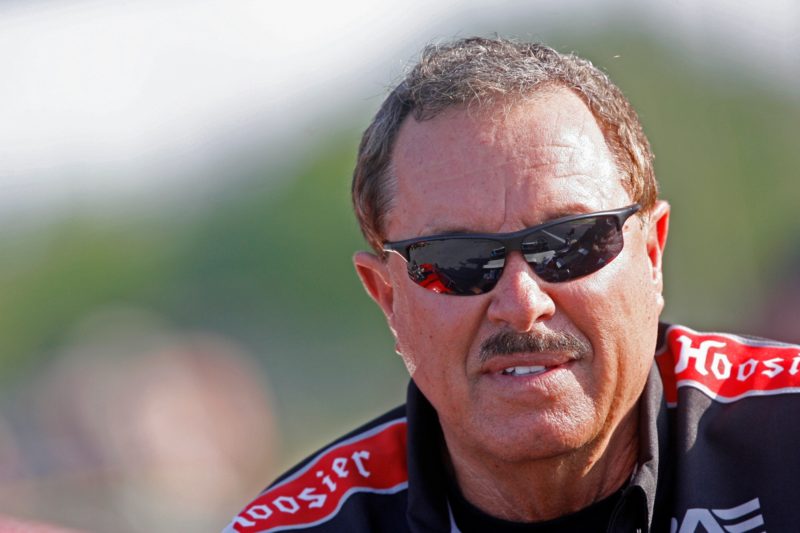
Mitchell Scruggs is up at 4 a.m. most days and says the time he spends each morning before dawn sweeping the sidewalks and parking lot in front of the massive Scruggs Farm, Lawn & Garden Home Improvement Warehouse is soothing and cathartic. It gets him ready for the inevitably hectic day to come.
“It’s a pretty simple job that when nobody’s around, you can do a lot of good thinking, productive thinking. It’s good to be able to collect thoughts and stuff when nobody’s around and you’re just out there cleaning up. It’s good for the mind, I think,” says Mitchell, a self-made multi-millionaire who drives a 10-year-old pick-up to work and still lives in the small farmhouse he built in 1974, the year his son, Jason, was born.
“I’ve always done that. For years when Jason was in school and even before he was born, I always ran the farm operation and the trucks and construction of companies and stuff that we do. I just did it on my own and I got used to doing that, getting up early and staying late. It’s what I’ve always done. I wouldn’t know any other way, but I’ve delegated a lot to Jason over the years and that’s helped a lot because what one person can do themselves is not so much, but if you can work with others and got family like Jason that’s out there, you can really get a lot done.”
Between the two of them, Mitchell and Jason Scruggs definitely get a lot done. After beginning in 1973 as a basic farm supply business, Scruggs Farm, Lawn & Garden Warehouse has grown to become one of the largest independently owned and operated retail outlets in the country, dwarfing most big-box stores and selling everything from anvils to zippers.
“We sell whatever you need for farming to make a profit out of it. There’s an on-site John Deere dealership with full parts and repair departments, as well as 13 qualified technicians. Tools, we’ve got a big tool department. We’ve got a huge lumber building on the back of our big building and we’ve gone up to 32 foot on framing materials, so you can build a whole house just out of the store,” Mitchell says with obvious pride in the sheer scope of his wares. “We’re a Bass Pro Shop dealer, too, so we’ve got everything you need for fishing and hunting.
“Garden center, all your major manufacturers’ appliances, plumbing, hardware, electrical, clothes, toys, anything you might can imagine that goes in a house,” he continues. “We do just about everything here. The only thing we’re not in is groceries, but we do have convenience. We’ve got milk and bread and drinks and beer and cigarettes and all that kind of stuff; we’re just not really deep in hard-core groceries.”
Beyond the impressive retail operation, the dynamic Scruggs duo also is responsible for a trucking company that operates 19 rigs in several states with specialized grain, fertilizer and tank trailers, as well as standard box trailers, primarily hauling goods within the Scruggs family holdings.
Then of course there’s the farming operation, a fertilizer production plant, a cotton gin, two home-building crews (three in the busy season), and the local Coldwell Banker real estate office. All told, the Scruggs employ approximately 250 people full time, with that number often swelling to more than 300 when seasonal workers are added to the payroll.
Mitchell insists a willingness to work himself is key to keeping so many others working alongside him.
“I’m the type of person that if I see something that needs fixing, rather than call one of the guys, I’ll do it myself. And Jason’s the same way. We try to take measures everywhere we can to save and make money, and that’s the reason we’ve been successful,” he stresses. “You can’t be afraid to get your hands dirty if you’re going to do well in business. You’ve got to be willing to work hard because that’s how you do well in anything. If you put a lot into it, you’ll get a lot back. If you don’t put anything into it, you’re not going to get anything back.”
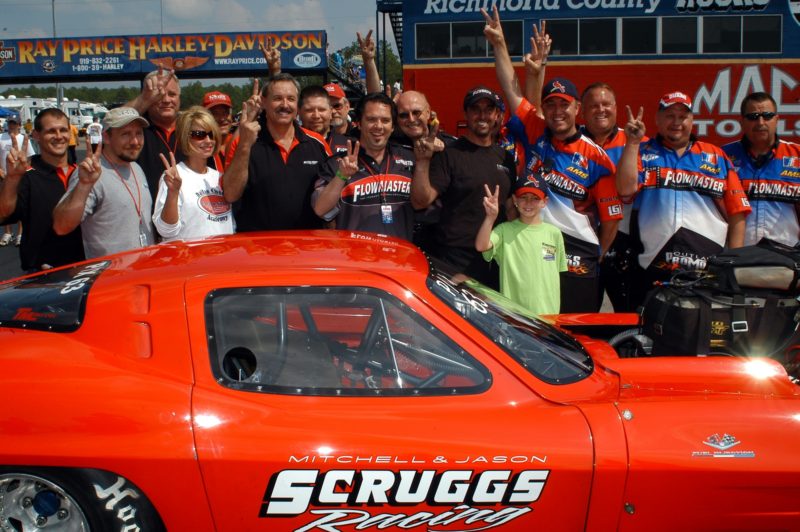
He reserves special praise for his son’s abilities, though.
“Jason, he took after my dad; he’s got a photostatic memory and he uses it really well to manage several different businesses. He’s able to keep up with everything that goes on by having that type memory. He runs a pretty big trucking company and then he manages the fertilizer plant and the farming operation and the cotton gins, so he’s got a lot going on, and the good memory really helps him do that,” Mitchell says.
“I just wasn’t blessed with that so I have to do it the hard way. I have to make sure that I document everything and have a good set of records. Not that he doesn’t; he does that as well, but it makes it a lot easier when you can just recall things and know what’s going on and what happened without having to go back and dig in the filing cabinet or on the computer all the time.”
That memory serves Jason well at the track, too, where he usually can describe what happened at a race a year ago or two years ago, right down to details about 60-foot times and half-track speeds—even for some of his competitors’ cars. “It really helps us in our racing,” says Mitchell, who points out that Jason also is among the best he’s ever seen at compartmentalizing all that retained information. One thing doesn’t seem to affect the other. He’s like that at the race track, too, able to work hard in the pits and then go out there and cut a light and drive the car, sometimes with literally no time to regroup or gather his thoughts.
“I think it’s because his day-to-day life is that way. Whether he’s closing out a new house or going to meetings with the county or going out there welding or beating a bearing on or off, or just doing whatever he’s got to do to keep something running, Jason can quickly move from one task to the next one and more often than not he’s going to make the best decision on each one,” Mitchell says.
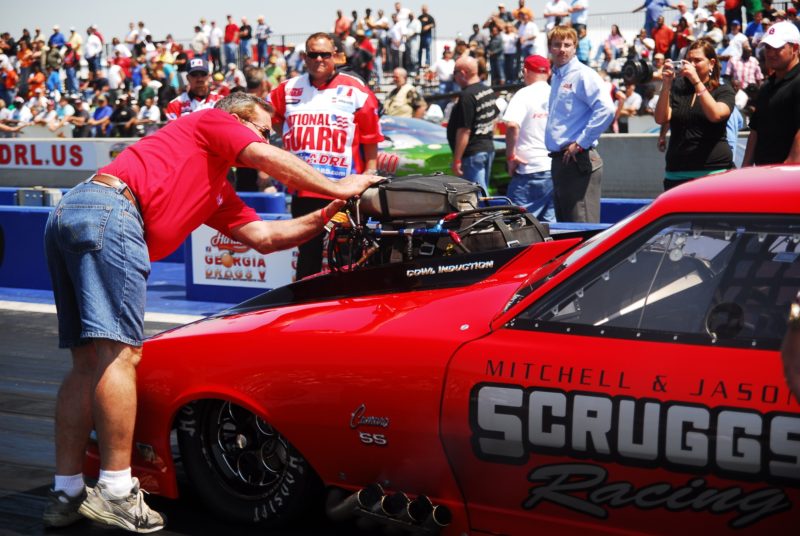
Considering the pressures of maintaining such diverse and expansive business interests, it’s no wonder Mitchell and Jason Scruggs need a release valve. But it’s not golf or boating on a local lake that takes up whatever precious free time they may have; instead they turn to drag racing one of the nastiest, squirreliest, wildest rides on the planet, an almost unrestricted, screw-blown Pro Extreme Corvette.
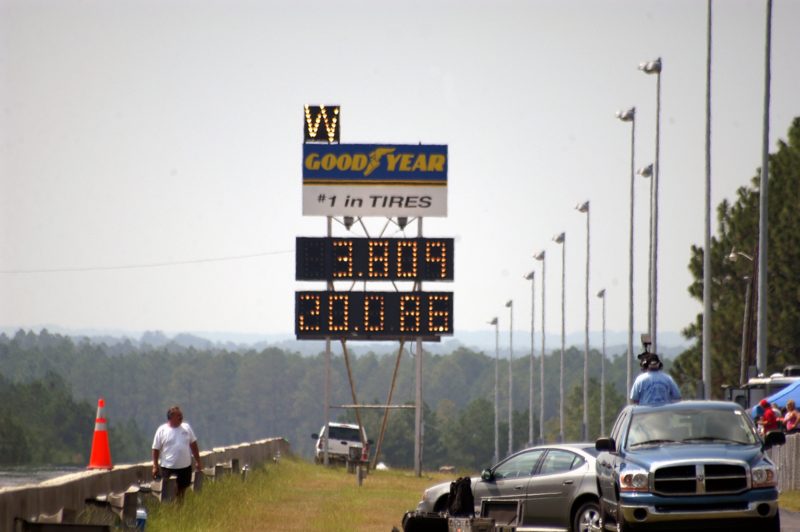 And as in business, the Scruggs race to win. With Jason driving and Mitchell calling the tune-up as crew chief, they are back-to-back American Drag Racing League (ADRL) world champions (2007-08), the first to break the 200-mph barrier over the eighth mile in a doorslammer (2007), and just last October at Houston they reset both ends of the official Pro Extreme world records to 3.52 seconds and 219.47 mph.
And as in business, the Scruggs race to win. With Jason driving and Mitchell calling the tune-up as crew chief, they are back-to-back American Drag Racing League (ADRL) world champions (2007-08), the first to break the 200-mph barrier over the eighth mile in a doorslammer (2007), and just last October at Houston they reset both ends of the official Pro Extreme world records to 3.52 seconds and 219.47 mph.
All that success doesn’t come easy, though. A Pro Extreme car is a demanding mistress, requiring the release of copious amounts of cash and many hours of careful attention between rounds and between races. The Scruggs, of course, take care of the first, but for the second they rely on long-term help from crew members Rhett Blankenship, Rickey Light and most recently Wesley Jones.
“If they knew I was in the field, Rickey and Rhett, they would come do what they could and try to help out. It’s a two- or three-hour drive for them, but on the weekends they would come and do stuff on the car as far as getting it ready and cleaning stuff up and that kind of thing. And all that goes a long way. I mean, a lot of people don’t realize just how much work goes into running one of these cars,” Jason says.
“It’s not like we’ve got all kind of mechanics. My dad and I do the majority of the mechanical stuff on the car, but there’s so much more than that. It’s a pretty good job just going from race to race, keeping the car clean, the fuel topped up, trailers cleaned out, the tires mounted, you name it.
“And all of our guys are volunteer guys; we don’t pay them anything other than a little gas money or something,” Scruggs adds. “They do it because they love it and we’re just a pretty tight team that tries to go have a good time, but at the end the day we want to run fast and we want to win. We’re pretty competitive.”
Ironically, one of the most important people on the Scruggs team has never actually seen them race. Eddie Scruggs, Jason’s uncle and Mitchell’s younger brother, is the one who stays home and takes over the lead on the farm when they have to go racing.
“I leave eight to 10 times a year depending on how many races we’re having. Which, I mean, it’s hard for me to leave; I’m not going to lie about it. But we work it all out and he pulls my slack and they get by here, but if it wasn’t for him I couldn’t race at all,” Jason states. “So we have him and another boy named Matt Hutchinson, he’s been with us since he was 13 years old and he’s kind of like part of the family, and between him and my uncle, they kind of cover things so we have time to get away.
“My dad, he’s the same way. He’s got some managers at the store that pulls his slack because he opens the store every single morning, seven days a week, so there’s not a day off for him. There’s some days he works from 5:30 to 9:30 at night and about half the time he does leave work about 6:00 or so in the evening. That’s a short day for him.”
Looked at from the outside it begs the question, why go to all that trouble? Why insist on racing a high-maintenance, high-dollar car that takes away so much time and commitment, not only from work but from friends and family at home? Why not just satisfy the itch with a weekend ride in one of Mitchell Scruggs’ four classic Corvettes (1959, ’63, ’64 and 2004) or three Camaros (a pair of ‘68s and a ’94)—all convertibles?
“I love those cars, especially the ’63 like my race car, it’s the most fun to drive,” Jason says. “And we did start out like everybody else at our local tracks, just doing it for fun—and we still do it for the fun of it—but we want to go fast and when you go fast, you’ve got to pay the price, whether it’s financially or through hard work or both.
“When we started following the ADRL series for points and stuff, we realized there was probably going to be three or four races that conflict in our busiest time, and it’s a lot for us to get off, but we realized that we enjoy doing it enough to try and make compromises to be able to go to most of the races.”
For Mitchell, the answer is simple; going racing with his son and teammates is fun. And believe it or not, relaxing.
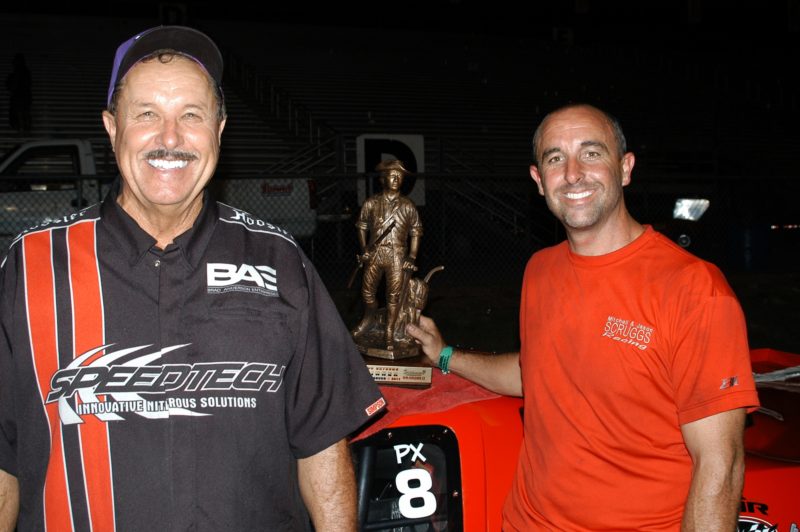
Again, to the outside observer that statement may seem at odds with reality. Even on the best of days it doesn’t necessarily look fun to perform even routine maintenance beneath a hot summer sun beating down on the black asphalt of the pits. And then there are times when the last qualifying run of the day sends the ScruggsFarm.com Corvette back to the pits with a blown-up engine, perhaps with a rod or two sticking through the block, the supercharger askew and oil coating nearly every part of the car from the front axles on back. Those 3 a.m. fix-it sessions with Jason elbows deep in motor up top, Mitchell on his back under the car and the rest of the guys carefully cleaning and cataloging parts for reassembly look neither fun nor relaxing.
Mitchell has been asked before: you’ve got the money, why not just hire a crew chief and mechanic to help prep and repair the car while you and Jason take it a little easier on race weekends—especially when things go wrong?
“Well, we enjoy working on the car. We don’t like to tear up stuff, but when it happens that’s all just part of it,” Mitchell answers. “I think the sense of accomplishment comes when you do well yourself. If you’ve got other people doing everything for you, where does the fun come from? Where does the sense of doing well come from if you hire people to do it all? They’re the ones that would have all the sense of accomplishment, the people that’s actually doing it.
“If our team did everything and we didn’t do anything, Jason and I didn’t do anything, yeah, if we owned the car it would be nice for our car to win, but it’s not the same as when you do it with your own hands and your own mind. Basically over the years Jason and I have done most everything on the car ourselves and I think it’s better that way. I mean, we’ve got some good guys that go with us to help because two people, it’s hard for two people to campaign a Pro Mod car themselves because it’s so much to do and you’ve got to do it so quick that you do need people helping. But it would be different if we had everything done for us. Like I said, it takes the fun out of it.
“And when you come back from races, it’s like you’ve been gone for a year or two and we haven’t been gone but for a few days, but you’ve got clear eyes,” he continues. “Everything looks different when you get back because when you look at something every day, it’s like you miss things and so forth, you overlook things that you could do better just because you’re used to seeing it all the time.
“When you’re gone for a few days and you come back, everything is somehow new to you again and you see things that you wouldn’t ordinarily see. So it can be really good for business, too, to have clear eyes, different eyes after you’ve been gone for a few days. It’s good that comes out of being gone sometimes.”
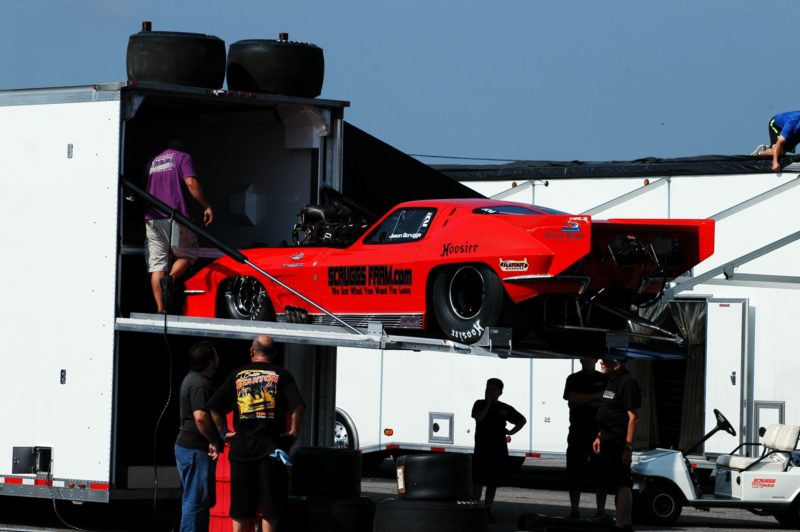
Perhaps it was one of those moments of clarity that led Mitchell and Jason Scruggs to their latest endeavor, though more likely it was simply the recognition they needed to ensure a venue remained to race their highly specialized, purpose-built hot rod. So, along with fellow Pro Extreme team owners Roger Henson and Gene Hector, as well as Pro Nitrous team owner Tommy Franklin, the five decided late last year to implement and finance the Professional Drag Racers Association (PDRA).
Essentially a replacement series for the floundering ADRL, which financially overextended itself and ran into purse payment troubles toward the end of its 2013 season, the PDRA is touted as being “by racers, for racers,” with veteran promoter Bob Harris of Piedmont Dragway’s Big Dog fame tasked with making it all happen.
The Scruggs were staunch supporters of the ADRL and its now-beleaguered leader Kenny Nowling since its inception in 2004, going so far as to lend Nowling the money he needed late in 2012 to buy control of the series back from Qatar’s Sheikh Khalid Al Thani, whose Al Anabi Racing gained control in 2010 and placed chassis man Tim McAmis in charge for the 2011-12 seasons. Additionally, the Scruggs provided and solely sponsored the track prep equipment used by the “Traction Twins,” Cale and Cody Crispe, throughout the 2013 ADRL schedule.
 Multiple changes in management tends to upset things—sometimes for the good and sometimes not so good—“and then you’ve got stuff that splits off and it kind of hurts both series,” Jason points out, referring also to the short-lived X-treme Drag Racing League (X-DRL), a spinoff from the ADRL that faltered halfway through its inaugural 2013 campaign.
Multiple changes in management tends to upset things—sometimes for the good and sometimes not so good—“and then you’ve got stuff that splits off and it kind of hurts both series,” Jason points out, referring also to the short-lived X-treme Drag Racing League (X-DRL), a spinoff from the ADRL that faltered halfway through its inaugural 2013 campaign.
“Nobody meant any harm, I don’t think. I mean, everybody has the same common goal. Everybody wanted the series that they were supporting to do good, and us, we were wanting the ADRL to survive and do well. We wanted to have a place to race. But I just thought that between splitting the cars and everything else that happened, it (ADRL) just wasn’t meant to be.”
Scruggs’ doubt for the ADRL’s future was not an isolated concern. With 2014 looming with little to no improvement in sight for the financial turmoil afflicting the St. Louis-based organization, on behalf of most ADRL-hosting track operators, Rockingham Dragway owner Steve Earwoodannounced early in December during the annual Performance Racing Industry (PRI) trade show, a hastily-thrown-together organization called the National Drag Racing Association (NDRA).
“As a group, we thought it was imperative to notify the racers that there will be a valid series for extreme Pro Modified racers in 2014,” Earwood explained of their motive at the time. However, within a week of the PDRA’s intentions being made public early in January, Earwood and the NDRA voluntarily ceded control and scheduling of the outlaw doorslammer world to the new organization.
“For the (ADRL) series to be in jeopardy prior to PRI, I just believed someone needed to address the issues and assure everyone that regardless of the sanctioning letters, there would be a series in 2014. Believe me, I do not care to run such an association myself,” Earwood insisted in a CompetitionPlus.com article at the time.
And just like Earwood felt compelled to act even if he didn’t truly want the responsibility, Mitchell Scruggs says he and his son can relate to the mixed message. They were concerned that nobody else was prepared to step up and make certain there would be a place in 2014 to continue all the classes and race teams the ADRL had created and nurtured for so many years.
“Really, it wasn’t anything Jason and I wanted to do. We’d a lot rather somebody else do it and that’s the reason that we loaned Kenny the money to buy the ADRL back because we had high hopes he could manage it and keep everything going and everybody would have a place to race,” Mitchell says. “It was a shame for ADRL, and for X-DRL, that neither one could work out. It’s sad for Jason and I both to see that happen.
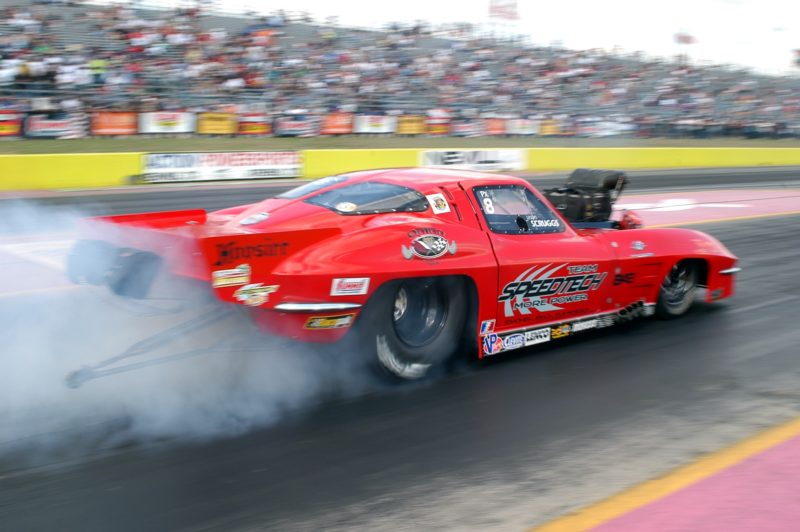 “But the way we see it, there’s probably around 300 of these door cars, or however many it is, that were depending on some type of association to have a place to race. And along with those 300 cars a lot of manufacturers depend on those cars to put their parts on, so it’s for their livelihood as well. And then you have all these race tracks that need those shows to make the tracks run well, so it was something that needed to happen and it didn’t look like it was going to happen. We just felt like we had to do something,” Mitchell says.
“But the way we see it, there’s probably around 300 of these door cars, or however many it is, that were depending on some type of association to have a place to race. And along with those 300 cars a lot of manufacturers depend on those cars to put their parts on, so it’s for their livelihood as well. And then you have all these race tracks that need those shows to make the tracks run well, so it was something that needed to happen and it didn’t look like it was going to happen. We just felt like we had to do something,” Mitchell says.
“To be honest, if we hadn’t stepped up, with Roger (Henson) and Gene (Hector) and Tommy (Franklin), too, I don’t think it would have happened. And I’m not taking the credit for it because it’s the manufacturers and race tracks that’s really stepped up with us; it’s been a team effort to put this together. Jason and I only had a small part of it. It’s been a lot of people.”
While certainly true that sponsors, tracks and racers have to buy in for the PDRA to gather momentum this year, Jason Scruggs realizes its success ultimately will require restoring confidence among everyone involved, including fans, by establishing stability and credibility within the organization. And like so many other things in racing, it all comes down to money.
“We’ve never really had a hand in trying to run an organization, but we just wanted to see something that we felt like was being run correctly and it takes a little bit of money to make that happen,” he says. “We’ve just got to be able to put a good organization in and spend money where we need to and save money where we can, if that makes sense. And I think we can do that.”
Having been involved with his dad in outlaw doorslammer racing since his mid-teens, Jason also is counting on his personal history and reputation, combined with those of Franklin, Hector and Henson, to help ease any concerns his competitors—now customers—might harbor about any start-up organization coming on the heels of the 2013 _DRL disasters.
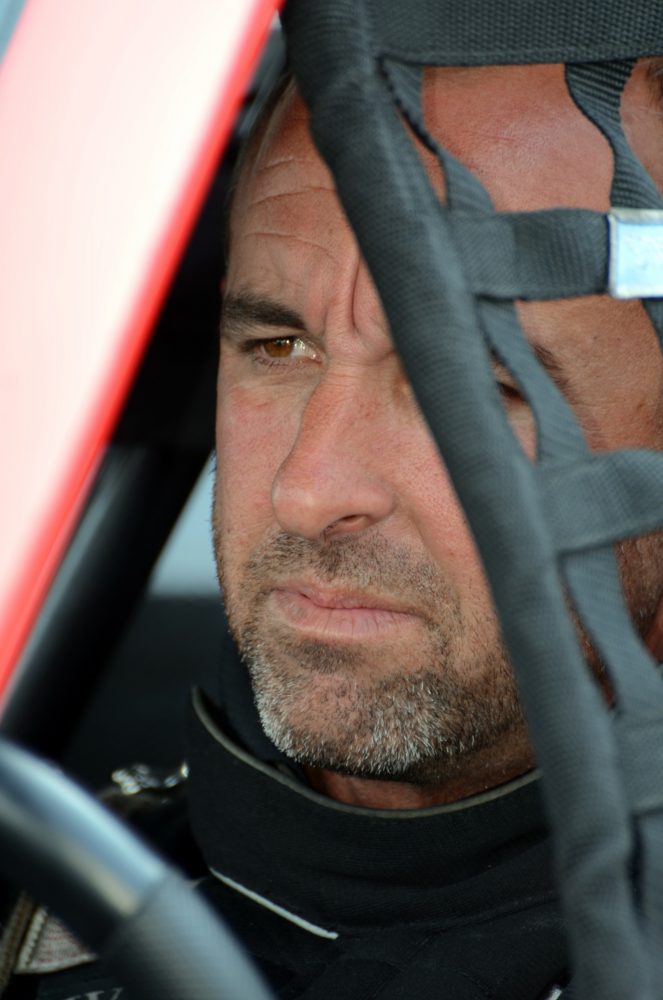 “It’s tough to make an organization work, especially one that has this many professional classes, because the payout is so expensive,” he recognizes. “And so it’s an art to it and we knew the first thing that we would do if we were going to do it is have a good foundation. So Roger Henson and Tommy Franklin and Gene Hector, I knew all those guys personally real well before this even started. They’re obviously like myself; we’ve got a common goal and that’s to have a real nice drag racing organization that we can all be proud of. We’re all racers and we just want a good place to race. So if it rains the race out and you’re the one that promoted it, you know you’ve still got to have enough money to pay it out of your pocket, even if it means losing money on that race. That’s just the way it’s got to be.”
“It’s tough to make an organization work, especially one that has this many professional classes, because the payout is so expensive,” he recognizes. “And so it’s an art to it and we knew the first thing that we would do if we were going to do it is have a good foundation. So Roger Henson and Tommy Franklin and Gene Hector, I knew all those guys personally real well before this even started. They’re obviously like myself; we’ve got a common goal and that’s to have a real nice drag racing organization that we can all be proud of. We’re all racers and we just want a good place to race. So if it rains the race out and you’re the one that promoted it, you know you’ve still got to have enough money to pay it out of your pocket, even if it means losing money on that race. That’s just the way it’s got to be.”
It’s not all about the Benjamins, though. Jason remembers what it used to be like, the original ADRL, back when he was winning his championships. There was a genuine sense of camaraderie mixed with the knowledge that something new and good was being created that permeated the pits. With the PDRA he’s hoping to bring at least some of that feel-good vibe back to the eighth-mile doorslammer world.
“I think we can have a great series and I think the PDRA this year, we’re going to go through a few growing pains, just like any business does, any new business, but at the same time, we’re not planning on making the same mistakes. And if we do make a mistake, we’re planning on fixing it. That’s our goal and there’s nobody here any more important than anybody else,” he states. “Every racer has a voice and we’re going to be racer-owned, racer-operated and racer-friendly, because at the end of the day, it’s all about the racers.
“I made a comment to Bob (Harris) the other day where I said, ‘You know, if a guy comes to our race and—just like I’ve had happen a few times—the car don’t cooperate or you don’t get down the track on a good run, you don’t qualify, I want all of them to still leave our races and say, Hey, you know what, I didn’t do very good but man, it was a good atmosphere, the race was well-run and I had a good time. That’s the attitude that I want the PDRA series to have. I know we can do it; it’s just a matter of getting it done.”

As far as his own race program goes, Scruggs will be getting it done this year with a brand-new, Garret Livingston-built ’63 Corvette coming out of Larry Jeffers Race Cars in House Springs, Missouri. The new car probably won’t be ready until May, but that’s okay, he still has the record holder sitting in the trailer, ready to start the season.
Externally it will be difficult for the casual observer to even see any difference between the two cars, but most significantly the new one will adhere to a PDRA minimum weight rule of 2,275 pounds, up 75 pounds from last year. Similarly, the Pro Nitrous minimum has increased an equal amount to 2,375 pounds and the all-new Pro Boost minimum has been set at 2,550 pounds. Ironically, the increased minimum weight for Pro Extreme entries affects Scruggs probably more than any other PDRA regular, “but at the end of the day we felt like it was best for the series,” he says.
“I did a lot of investigating into the weight rule for Pro Extreme and anybody that knows me through the years knows I’ve been pretty vocal about not having a weight rule. All through the years with the ADRL I didn’t want a weight rule; and to be honest, I still don’t want a weight rule. But I felt like that it was our way of saying that we can all compromise and do what’s best for everybody. So that’s the way it is.”
Still, while Scruggs—and the rest of the PDRA’s financial backers—may wield significant influence on the rules package for each class, for each of the eight races on the schedule this year they all become just competitors, open to the same calls and rule interpretations by which everyone is expected to abide.
“What people need to understand is that we’re involved, my family and these other owners are involved in this thing on the hardcore business decisions and the financial end of things. But we’re not involved in the day-to-day activity of putting the race on because there’s no way we can be involved like that and race, too,” Scruggs says.
“Bottom line, we’re going to get treated just like everybody else. And Bob Harris and the PDRA competition director, Rick Moore, and whoever else might be involved in the future that we have is expected to treat each of us exactly the same as they would treat everyone else.”
 For the time being, Scruggs is focused on making the trek early in April to North Carolina’s historic Rockingham Dragway for the PDRA’s 2014 season opener. Rockingham also is the site of arguably his most memorable, if not most historically significant accomplishment when he broke the 200-mph barrier. It’s certainly part of the lore that makes Scruggs one of the most popular and well-known doorslammer racers in the country, stemming from the late-‘90s when he was tearing down tracks and tearing up track records with a blown small-block combination that probably shouldn’t have been capable of going as quick and fast as it did.
For the time being, Scruggs is focused on making the trek early in April to North Carolina’s historic Rockingham Dragway for the PDRA’s 2014 season opener. Rockingham also is the site of arguably his most memorable, if not most historically significant accomplishment when he broke the 200-mph barrier. It’s certainly part of the lore that makes Scruggs one of the most popular and well-known doorslammer racers in the country, stemming from the late-‘90s when he was tearing down tracks and tearing up track records with a blown small-block combination that probably shouldn’t have been capable of going as quick and fast as it did.
Scruggs raced a lot back then, a lot more than he does today, building his reputation and his fan base 20, 30, 50 people at a time with record-setting runs at small tracks throughout Georgia, Tennessee, Alabama, Texas, the Carolinas, and of course, his home state of Mississippi.
“Wherever they were having the Quick 8s, I wanted to go, or if somebody wanted me to come match race or something, I’d be there,” Scruggs recalls. “We run that thing pretty successfully back in those days, but it got to where that car was still fast for the tracks and everything and we’d go out there and run 3.90s consistently, win our share of races with it, but I kept telling my dad, ‘I want to go fast; I want to go faster.’
Significantly, the first Dragstock race in 2004 at Carolina Dragway, the event that directly led to the creation of the ADRL, was one of the first in which Scruggs experimented with his now familiar screw-blown Hemi combo. In fact, he qualified both cars that weekend, though the small-block entry was withdrawn from competition before eliminations began, thus signaling the direction Scruggs ultimately was heading.
“I said I think if we built a Hemi car, we could run 3.80s; that’s about the mindset I had 10 years ago. Then when we started to run 3.80s, I was like, maybe we can run 3.70s. And then in 2007 I run the first 200 mile an hour and 3.70 flat. That was pretty fast in that day, but if you look now, just since 2007, we went from 3.70 to 3.52—with a torque converter! You never would have led me to believe 10 years ago that we’d ever be running 3.50s with a torque converter.
“I think it’s just technology and people getting smarter about how to run the cars, but a lot of it is track prep, too,” Scruggs says. “When the Traction Twins come along and the tire machines, that changed a lot, and these tracks we’re running on now are really nice and we’ve learned how to run on them, but bottom line, you’ve got to have a good track to run on to go this fast.”
Given his obvious taste for going fast, it begs the question; why has Scruggs never ventured into the nitro arena? It’s not that he hasn’t thought about it at times, and his dad even made some fuel Funny Car inquiries back in the early 2000s, before the Scruggs found the ADRL. But Jason says in the long run he simply doesn’t have time for it—“We do good just to get to the races we do now, a few a year.”—and actually prefers what he’s currently doing.
“I’m a doorslammer guy and I’d rather have a—not that it’s legal for PDRA, before anybody gets any ideas—but I believe I’d rather have a nitro motor in a doorslammer, to be honest. There’s just something about doors opening and shutting,” he says. “I’ve always loved Pro Stock and Pro Mod, and I think there’s something about making a car go fast on a suspension, too; they’re a little bit unpredictable, so it makes it more exciting.
“And any nitro car, you’ve pretty much got to have a full-time crew. You basically go through so many parts and really, maybe I’m wrong, but it just looks like it’s not that much fun. If you’re the one having to buy the parts or the one working on the motors, it doesn’t look like that much fun to me. So I just think it’s a little bit of all those reasons why I’ve never really seriously wanted to do anything in a nitro car.
“But of course I think they’re impressive and I like the kind of speed they’re running and obviously that’s what you’re going to have to do, but for us, we’re going to keep pecking away. Hopefully one of these days, I’ll run 220s and 3.40s and be able to say I can do it in a doorslammer.”

Perhaps a step closer to those magical numbers will come soon at “The Rock,” when the PDRA’s inaugural season finally gets underway.
“I can’t wait,” Scruggs declares. “Really, I can’t. We’ve still got a few things we’ve got to get done between now and then, but Rockingham, we’re excited. We know come April, we’re going to have a great race. We’re going to bring back the fun and the excitement. This is going to be a great year with the PDRA.”
In the end it’ll just be another juggling act for Scruggs, who if he’s not the busiest man in drag racing, he certainly knows how that guy feels.
Photographs by Mark J. Rebilas and Ian Tocher
